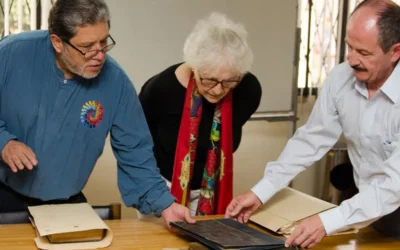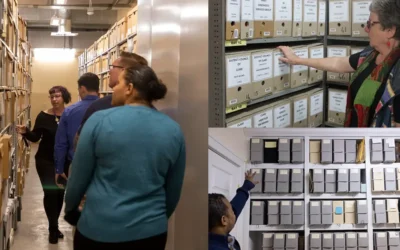Keys to Developing a Comprehensive Archives Collection Development Policy
Margot Note
Archives and special collection development policies should state what the organization currently holds and the collecting areas, especially records of enduring value that represent the organization’s history. A policy will not only formalize the archives program, it will allow you to focus on what you would like to acquire as well as to disregard materials that fall outside of the collection. Focusing on what you will not collect will also allow you to deaccession materials that should not be in the collection.
The policy should be a public document, made available on the organization’s website, and shared with stakeholders, organizations collecting in similar areas, and with select national and international organizations.
Formal Policies are Foundational
A recent client was preparing to launch a formal archives and special collections program after years of informally collecting materials. After my two-day visit, I wrote an evaluation report to guide their work in setting up the archives with short, mid-range, and long-term goals. Step one was to write and get approved a formal collection development policy, since all other activities stem from this document.
19 Important Elements to Consider
All archives and special collection development policies should consider the following:
- Under what authority does your program operate or is governed?
- What is the organization’s mission, vision, and history?
- Who makes decisions about what to accept? Major acquisitions may need approval at a high level.
- What is the purpose of the program?
- What is the history of the program within the organization?
- Who is your audience? Who uses your archives and special collections?
- What is the scope of the collection? List the subjects, people, timeframes, and geographic areas your program focuses on. Describe the kinds of materials your program collects. This section can include a review of the collection’s strengths and weaknesses. It often sets guidelines for growing and developing the collection.
- What formats can the repository responsibly manage or book collections, what are your policies on editions (firsts, impressions, dust jackets, reprints, paperbacks, translations) and duplicates? What are the policies regarding acquisitions and accessioning? The archives must ensure that each accession not only enhances or strengthens the archives collections but can be cared for and used. This section outlines the specific criteria and decision-making process for adding objects to the collection. Having a thoughtful accession/acquisitions policy will yield a strong and cohesive collection, in addition to helping avoid any misunderstanding between potential donors and the archives. For example, if an item does not fit the criteria for being accessioned, the staff member can back up the decision with the policy. The archives should include any legal or ethical obligations or restrictions concerning collection acquisition (e.g., appraisals, gifts, exchanges). Ask yourself: How will materials be accepted into the collections? Will records be actively sought? Will collections be bought and with what funds? Who will approve acceptance of materials? Through what means will legal custody be obtained?
- What are your policies regarding deaccessioning? In thinking through the deaccessioning policy and its subsequent procedures, it is important that archives clearly outline the specific criteria for removing an object from the collection, as well as describe the decision-making process.
- What are your access policies? Archives must give the public reasonable access to collections and collections records. In this section, the archives explains who has access to what collections and why, and denotes how those collections will be used. Archives might assess staff capacity, physical facilities, preservation and awareness of legal issues (e.g., Americans with Disabilities Act, donor privacy, Freedom of Information Act) before shaping these policies. Will loans of materials be made to other organizations and will they be accepted by your organization? Under what circumstances? What are the conditions of the loan and for its termination?
- Are you legally required to collect certain kinds of materials?
- How do you handle issues of ownership and title, copyright, data protection, and freedom of information? What materials will have limited access because of these issues?
- How will you handle preservation issues? Will you take items in poor condition and, if so, under what circumstances?
- How does this collection policy fit into the collecting policies of other libraries? Who else collects in your subjects and region? Can you work together for mutual benefit?
- Under what authority and circumstances will unwanted materials be removed from the collections? What procedures will be used to document this activity?
- How often will the policy be reviewed? Regular review can uncover issues that have caused problems, the impact of new collections, and changes in technologies and practices.
A Future-Oriented Intellectual Framework
Collections planning begins with an intellectual framework that states the rationale for the collections and strategic, integrated collecting. Its compelling vision defines the organization’s unique role and provides the context for making decisions about the future of the collections. The collections plan will serve as a blueprint for the future and as a statement of long- and short-range needs, of acquisition priorities, and of collecting boundaries. With its objectives and priorities, a plan gives stakeholders a yardstick by which to measure progress. Its recommendations will also serve as an advocacy tool to enlist the support of stakeholders. The collections plan will articulate a vision for the future in the age of information.
Margot Note
Similar Posts
Enhancing Collaboration; Methods for Archivists
Archivists can enhance collaboration through user-centric approaches and efficient processing methods based on customer service principles.
Navigating Selection in Archival Practice
The archival selection process is far from straightforward, given the limitations of long-term preservation and ongoing accessibility challenges.
Responsible Stewardship in Archival Practice
Responsible stewardship is a philosophy that guides the actions and decisions of archivists in safeguarding collective memory.
A Modern View of a City’s History via ArchivEra
Brief success story on City of Regina Archives’ use of ArchivEra to manage collections of legal, historical, administrative or financial significance
Hosting service
Enjoy all of the benefits of your Lucidea solution with secure, reliable, stress free hosting
Programs & incentives
No matter your size or budget, we’ve got you covered, today and tomorrow



